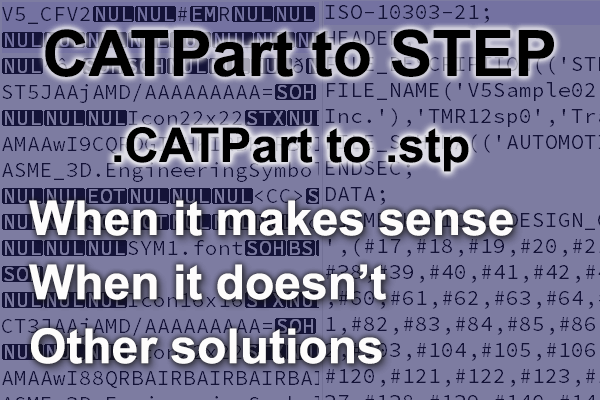 CATPart to STEP refers to translating or converting a native CATIA CAD model to the neutral STEP CAD format.
CATPart to STEP refers to translating or converting a native CATIA CAD model to the neutral STEP CAD format.
This article will discuss some of the reasons you may want to do this, reasons you may not want to do this, and other formats you might want to consider translating to.
This translation can also appear as CATIA to STEP, .CATPart to .STEP, CATProduct to STEP, .CATProduct to .STEP, .CATPart to .stp, and .CATProduct to .stp.
The CATPart Format
The CATPart format is created by CATIA. The other two 3D CAD formats which can be created by CATIA are CATProduct, and Model. CATPart and CATProduct extensions are used for CATIA V5 and V6; the difference between them is that CATPart files are part files, and .CATProduct files are assemblies which contain .CATPart files. Model files can be parts or assemblies created in CATIA V4.
The STEP Format
STEP stands for the ‘Standard for the Exchange of Product Data’. It is an international standard which began life in 1984 at an ISO meeting hosted by NIST (National Institute of Standards) and attended by representatives from several countries. STEP took IGES (International Graphics Exchange Standard), to the next level and is still in development today. However, there is some flexibility in how a STEP translator can be written, and some STEP translators are written as cheaply and easily as possible, converting all NURB (Non-Uniform Rational Basis Spline) geometry to splines, which do not as accurately describe the geometry, or leaving out entities that may be unique to a given CAD system. For those reasons, it is generally better to use a Kernel format such as Parasolid or ACIS when possible.
An Illustration of CATPart to STEP
If you have some CAD data that originally came from CATIA and you want to pass that data to another user, but you are not sure of their CAD Read capabilities, CATPart to STEP makes sense, because almost every CAD application will be able to read STEP. Using STEP also makes sense if you don’t have the ability to write the native or kernel format for the destination CAD application.
Keeping the Model in the CATPart Format
If, however, you know that your customer has access to CATIA, or to a good translator that can read CATIA formats such as CATPart, CATProduct and .Model, the best solution is to send them the CATIA file directly. That way, you retain the most possible information in the file. Not all CATIA translators are created equal, however, so if you’re having trouble reading CATIA CAD data at any point, consider trying TransMagic’s eval which will read all CATIA formats – and see if you have any better success.
Translating to a Geometric Modeling Kernel Format
Geometric Modeling Kernels are formats that actually describe geometry directly in CAD systems. For example, SOLIDWORKS and Mastercam use the Parasolid kernel to define geometry. If you know your CATIA file is going to end up in a Parasolid-based CAD application, you can send that customer or supplier that exact kernel. As mentioned above, geometric modeling kernels are more precisely written than STEP and IGES translators, so when using them, you stand to transmit more original and accurate information. If you want to know which CAD application uses which geometric modeling kernel, see the article ‘Which Geometric Modeling Kernel?’.
Translating to STEP
STEP is your last reasonable option (IGES is usually not a good choice), but if you are going to use STEP, make sure you’re using a good STEP translator; because, as has already been mentioned, there is a lot of latitude in how a STEP translator can be written. And be aware that whatever format you convert your geometry to, the receiver of the file will also have to read that format, and so you are banking on them having a good STEP reader as well. Writing to STEP, and reading the STEP file – that’s two opportunities for a bad STEP translator to muck up your once-pristine geometry.
Test Drive TransMagic
You can test drive TransMagic SUPERVIEW, along with MagicHeal and MagicCheck Add-Ons for 7 days at no cost – just click this link to get to the free eval. If you need to be able to write CAD formats (such as STEP) to do a proper eval, you will be prompted during the eval process for how to upgrade, or you can let us know at sales@TransMagic.com.
Related Articles
The CAD Format Ladder and the CAD Format Ladder Part 2 cover why some CAD formats are better than others.
See a reference list of all CAD Extensions
See a listing of all the CAD formats TransMagic can Read / Write
Which Geometric Modeling Kernel? Covers the most popular modeling kernels and which CAD applications they power; it’s a handy list if you need to get the best possible CAD data to a customer or supplier who is using one of the listed applications.
IGES covers some of the IGES format’s many shortcomings in spite of the fact that it was a new, international exchange format that changed the world.
